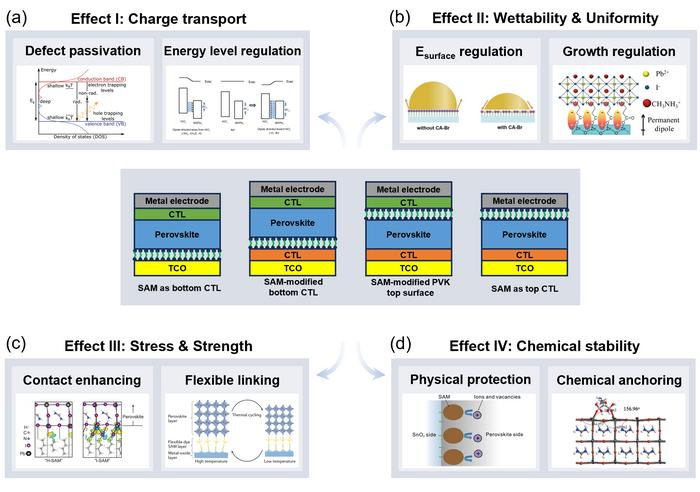Reviewed by Lexie CornerJun 11 2025
Researchers have developed hole transport materials such as Spiro-OMeTAD, NiOx, PEDOT:PSS, and PTAA. Common electron transport materials include TiO2, ZnO, SnO2, C60, and PC61BM.
 Applications of SAMs in perovskite optoelectronic devices, along with their four functional roles and corresponding atomic-scale mechanisms. Image Credit: Science China Press
Applications of SAMs in perovskite optoelectronic devices, along with their four functional roles and corresponding atomic-scale mechanisms. Image Credit: Science China Press
Metal halide perovskites have been used in solar cells, photodetectors, light-emitting diodes, and lasers. These materials are known for their low exciton binding energy, high carrier mobility, strong optical absorption, tunable bandgap, and low-cost processing.
Their performance is based on specific electronic structural properties. These include Rashba spin splitting, band-edge antibonding states, cross-bandgap hybridization, and notable band-edge dispersion. Progress in perovskite optoelectronics has been supported by improved understanding of the relationship between material structure and properties.
As of 2024, the power conversion efficiency of perovskite solar cells (PSCs) has exceeded 26 %. The external quantum efficiency of perovskite light-emitting diodes (PeLEDs) has surpassed 30 %.
Scaling up production requires improvements in efficiency and long-term stability, along with reduced biological and environmental risks. These challenges span all stages, from material design to device fabrication.
PSCs and PeLEDs share similar core components, including active layers, charge transport layers, and electrodes. Over more than a decade, the composition of perovskite active layers has undergone significant optimization. Surface and interface engineering now play a key role in determining device performance.
Despite advances, several issues remain. These include high processing temperatures, limited stability, interface defects, parasitic absorption, and high costs. To address these, researchers have applied self-assembled molecules (SAMs) in perovskite devices. SAMs function as surface modifiers for bottom transport layers or top perovskite layers, and can also serve as independent transport layers.
The article "Role of Self-Assembled Molecules in Halide Perovskite Optoelectronics: An Atomic-Scale Perspective", recently published in National Science Review (NSR), provides an in-depth review of SAMs. It was authored by Professor Lijun Zhang from the School of Materials Science and Engineering and Associate Professor Yuhao Fu from the School of Physics at Jilin University, along with collaborators. The first authors are postdoctoral researchers Xiaoyu and Xue Wang.
The article examines how SAMs contribute to the performance of perovskite optoelectronic devices. It focuses on atomic-scale interface mechanisms and highlights strategies for molecular design.
SAMs influence device performance through four main types of interactions with functional layers:
-
Energy-level alignment and defect passivation: SAMs use dipoles to align energy levels at interfaces and passivate defects, improving charge transport.
-
Surface modification and growth control: SAMs adjust surface energy and control growth kinetics, enhancing film uniformity and wettability.
-
Stress relief and interfacial bonding: Their flexibility and bonding characteristics help relieve mechanical stress and improve adhesion.
-
Chemical stabilization: SAMs offer steric hindrance and anchoring effects that inhibit unwanted reactions and phase segregation, improving chemical stability.
These principles support the use of SAMs in both single-junction and tandem PSCs, as well as in PeLEDs. SAMs have become a valuable tool for enhancing both efficiency and stability.
The article explores the evolution of SAMs, their structural and physicochemical properties, and how they are applied in devices. It analyzes how SAMs affect interfacial characteristics such as charge transport, film uniformity, mechanical strength, and chemical resistance.
By detailing atomic-scale mechanisms, the study explains the origins of SAMs’ interface-modifying effects. It also discusses challenges in their characterization, integration, and design, offering potential solutions and directions for future research.
Journal Reference:
Wang, X., et al. (2025) Role of self-assembled molecules in halide perovskite optoelectronics: an atomic-scale perspective. National Science Review. doi.org/10.1093/nsr/nwaf150